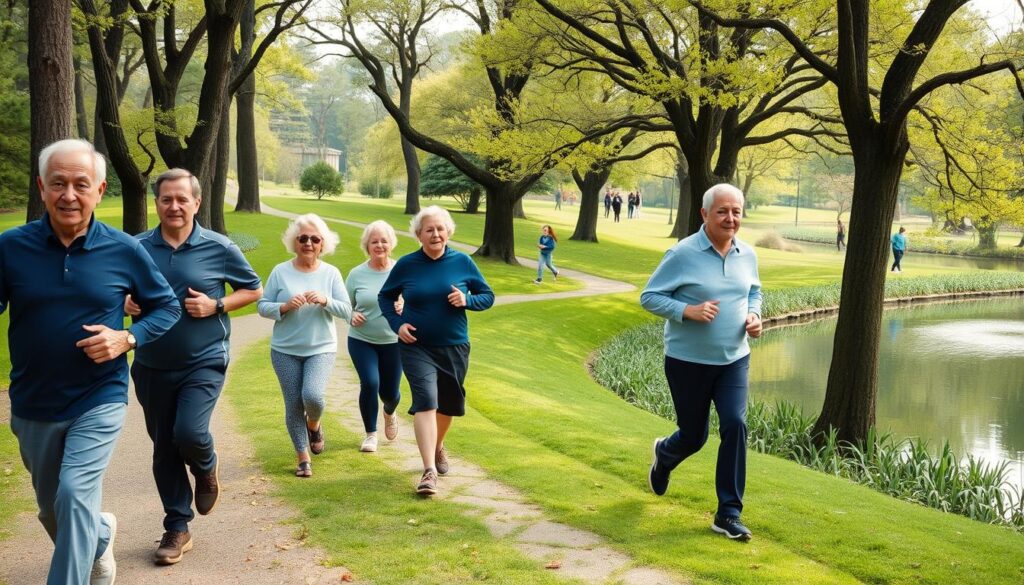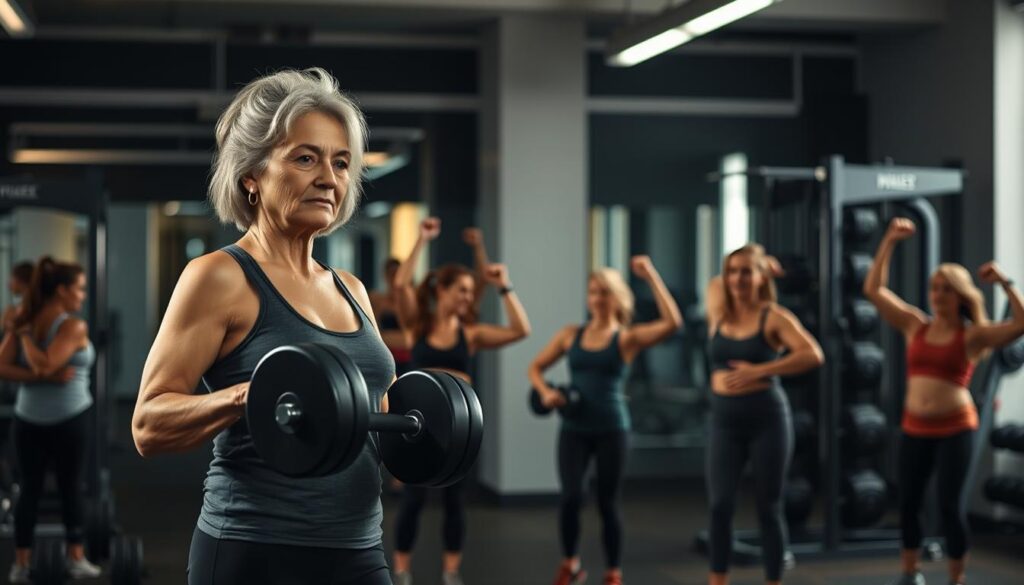What if the secret to a longer healthier life isn’t hidden in a pill but in movement? Research reveals that regular physical activity can turn back time at a cellular level.
A 2017 study in Preventive Medicine found active adults had telomeres the protective caps on chromosomes comparable to those nine years younger.
Programs like StrongWomen by Tufts University prove strength training boosts mobility and independence in older adults. Meanwhile Japan’s Interval Walking Training IWT offers a simple yet effective way to maintain vitality. Despite these findings many healthcare systems overlook movement as a key to longevity.
From sharper minds to stronger muscles, the science is clear: staying active isn’t just about fitness it’s about rewriting the aging process itself.
Key Takeaways
- Physical activity may reduce cellular aging by nearly a decade.
- Strength training improves functional independence in older adults.
- Interval walking combines accessibility with proven health benefits.
- Exercise supports cognitive function and muscular health.
- Healthcare often undervalues movement for longevity.
Exercise an Ally Against Aging The Science Behind It
Science confirms that movement doesn’t just strengthen muscles it rewinds cellular clocks. Decades of research reveal how physical activity alters biology to combat age related decline. From chromosome protection to sharper cognition the evidence is undeniable.

Telomeres and Cellular Youth
Telomeres, the protective caps on chromosomes, shorten with age. A 2017 Preventive Medicine study found that active adults had telomeres equivalent to those nine years younger. Movement reduces oxidative stress, a key factor in telomere erosion.
Muscle and Bone Fighting Sarcopenia and Osteoporosis
After age 30, muscle mass declines by 3–8% per decade. Resistance training reverses this: a 2019 meta-analysis showed an 11% increase in older adults. Tufts University’s nursing home trial saw 28% better stair climbing ability after strength workouts.
Brain Health Sharpening Memory and Cognition
Aerobic exercise boosts blood flow to the brain lowering dementia risk by 30%. Rutgers University linked dance classes to improved memory flexibility. This happens partly through BDNF a protein that supports neuron growth.
Interval Walking Training IWT Japan’s Anti Aging Secret
Japan’s innovative approach to longevity combines simplicity with science. Interval Walking Training IWT developed by Shinshu University transforms ordinary walks into a powerful tool for vitality. Unlike intense workouts IWT is designed for aging joints while delivering HIIT like benefits.

How IWT Works: Fast and Slow Cycles
The protocol alternates 3 minutes of brisk walking 70% effort with 3 minutes of gentle pacing 40% effort. Repeat this cycle five times four days a week. This rhythm maximizes cardiovascular gains without straining joints.
Proven Benefits: Aerobic Capacity and Disease Risk
A 2019 Mayo Clinic Proceedings study found IWT users boosted aerobic capacity by 14% in five months. It also slashed lifestyle disease risk by 17%, including hypertension and diabetes. Japanese cohort data show improved blood pressure and insulin sensitivity.
Why It’s Perfect for Older Adults
Matsumoto city’s program saw seniors regain mobility comparable to peers 10–15 years younger. No equipment is needed, and intensity adjusts to individual ability. Compared to traditional walking, IWT yields 23% better endurance gains Exercise and Sport Sciences Review, 2017.
- Accessible: Requires only comfortable shoes and open space.
- Scalable: Intensity based on perceived exertion, not speed.
- Evidence-backed: Validated by peer-reviewed research.
Strength Training for Women Tufts University’s Lifelong Lessons
Tufts University’s research reveals how strength training reshapes aging for women. Far from bulking up lifting weights preserves mobility, bone integrity, and independence. Their findings debunk outdated fears while offering actionable solutions.

Weight Lifting and Bone Density
A 2003 Medicine & Science study showed postmenopausal weightlifters gained 1.3% hip bone density yearly. Resistance training triggers osteoblast activity, slowing osteoporosis.
Loading bones is like depositing savings it compounds over time
explains Tufts’ Dr. Miriam Nelson.
The StrongWomen Program Real Life Success Stories
Tufts’ program combines dumbbell squats, step-ups, and farmer’s carries. Participants report 22% faster walking speed and 34% fewer falls. One 68-year-old regained the ability to carry groceries: I play with my grandkids without worrying about my back.
Functional Gains: From Walking Speed to Independence
A 1994 NEJM study found 87-year-olds doubled muscle strength in 10 weeks. Community based training boasts a 78% adherence rate Journal of Physical Activity and Health 2015. The benefits extend beyond the gym easier stairs steadier balance, and renewed confidence.
- Myth Busting: Lifting weights won’t make women bulky it protects joints and posture.
- Scalability: Exercises adapt to fitness levels, from beginners to active seniors.
- Longevity: Strength training adds years of functional independence.
The Habit Factor Why Consistency Beats Intensity
Small, daily efforts outperform occasional intense workouts for long-term health. A 2021 Lancet Public Health study found adults with steady routines had a 35% lower mortality risk than weekend warriors. The CDC echoes this: 150–300 weekly minutes of moderate activity, plus strength training, yields the best results.
Longevity Studies The Power of Routine
Japanese researchers highlight group walks as a keystone habit. Seniors in Matsumoto who practiced IWT consistently improved endurance by 23%. Similarly JAMA Internal Medicine 2020 showed 70-year-olds reduced disability risk by 41% even when starting late.
How to Build Exercise into Daily Life
Habit-stacking works: pair post-meal walks with coffee or phone calls. Baylor Scott & White Health suggests beginning with 10-minute intervals gradually increasing time. The CDC’s Move Your Way tool helps personalize plans.
Late Starters Can Still Win Big
Age is no barrier. A 2019 study found adults over 60 gained muscle mass within eight weeks of resistance training. As one participant noted, It’s never too late to feel strong again.
- Start small: Five-minute walks build into 30-minute routines.
- Socialize it: Pair exercises with a friend for accountability.
- Track progress: Use apps or journals to celebrate milestones.
Why Exercise is Still Overlooked in Aging Care
Modern healthcare often misses a critical tool for longevity: movement. Despite proven benefits systems prioritize pills over lifestyle changes. A 2020 American Journal of Medicine study found only 16% of patient visits include activity advice.

The Pill Popping Bias in Modern Medicine
Drugs dominate aging care due to billable treatments. The 2018 British Journal of Sports Medicine cited exercise underdosing as a systemic flaw. Pharmaceutical lobbying outspends non-profit health advocacy 20:1.
Cultural Barriers to Movement
U.S. car-centric design discourages walking, unlike Japan’s walkable cities. The CDC reports 75% of adults miss activity goals. People view movement as optional, not medicinal notes Baylor Scott & White center director Dr. Elena Ruiz.
Educating Doctors and Patients
Med schools average diabetes risk by 19% Journal of Gerontology, 2021.
- Policy shifts: Advocate for insurance-covered movement programs.
- Urban planning: Design communities that encourage walking.
- Provider training: Teach doctors to prescribe exercise like medicine.
Conclusion Making Movement Your Lifelong Ally
Movement reshapes aging offering vitality through simple, science-backed habits. From Japan’s IWT to Tufts’ strength programs the benefits are clear: disease prevention, stronger bones, and sharper minds.
As Tufts researchers assert physical activity is a prescription for life valuable at any age. Policy changes must prioritize movement, but personal routines matter too. Start small stay consistent, and celebrate progress.
Like Rutgers’ dance study shows, movement lets your brain dance through later years. The path to lasting health isn’t hidden it’s built step by step.





